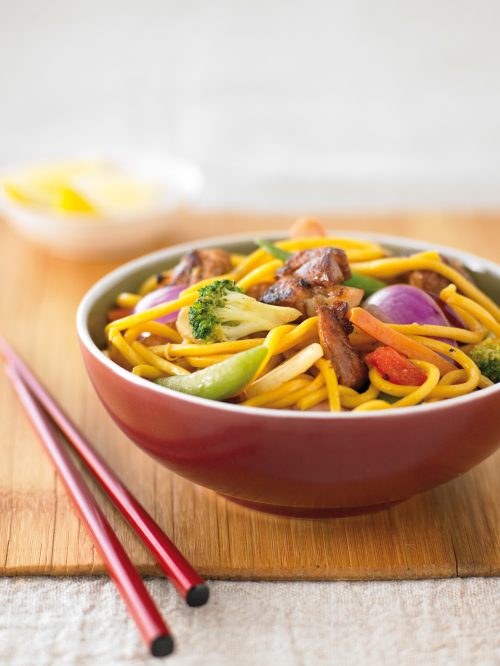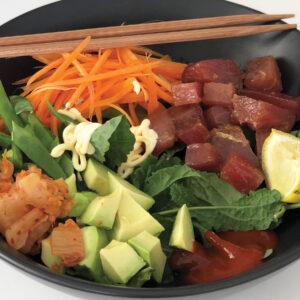
Noodles are a cheap and easy pantry staple, so which are the healthy choices?
Noodles, once the speciality of Asian restaurants and noodle houses, are now commonplace in Kiwi homes. And with the wide variety available, Kiwis are certainly not starved for choice.
Noodles are made from grain or legume flours – rice, wheat, buckwheat and mung bean – and mixed with water, oils and additives such as salt, colours, raising agents, anti-caking agents and/or preservatives. Tapioca starch is sometimes added to improve the texture and the tenderness of noodles.
In supermarkets, noodles are sold as dried or shelf-fresh (soft). The difference? Dried noodles are dried before packing so they will last for months after production, whereas 'shelf-fresh' noodles haven't been dried but contain preservatives to extend their shelf life.
Noodles are categorised by what they are made from: rice, wheat, egg and gluten-free flours, or a combination of them. Noodles are also categorised by the shapes they take.
What are the choices?
Rice noodles
Rice noodles are typically made with rice flour and water, so are generally gluten-free. They can be very wide, flat rice noodles or rice vermicelli – very thin rice noodles. Avoid noodles fried in oil – they are higher in fat and energy.
Wheat noodles
Wheat noodles are made from a combination of wheat, rice and buckwheat flours plus starch or gluten and salt. Varieties include:
Udon: thick, white noodles from Japan which are either dried or shelf-fresh varieties.
Egg noodles: the type found in instant noodle snacks, these can be thin, or wide and flat.
Ramen: dried, wheat-based Japanese noodles made with lye water – a type of alkaline mineral water containing sodium carbonate and potassium carbonate. They can also be made with egg.
Hokkien: thick, yellow, chewy noodles with lye water, egg, or added artificial yellow colouring. In shelf-fresh or fresh varieties.
Singapore: thin, yellow noodles with lye water, egg, or added artificial yellow colouring. Dried or shelf-fresh.
Gluten-free noodles
These include the rice varieties above but also noodles made from buckwheat – such as dried, thin soba noodles (check the ingredients list as some soba noodles have wheat) or dried glass noodles – and bean vermicelli made from mung bean flour. Always check the ingredients on the label to confirm they are gluten-free. Gluten-free noodles tend to have a high GI (Glycaemic Index), so eat them with meat and vegetables to help lower the GI of the meal.
Instant noodles
As instant noodles are traditionally fried during processing, the fat content can be over 15g per single serving pack – high by everyday food standards. Instant noodles can also be high in sodium and artificial flavours.
What's on the label?
Check the per 100g column in the Nutrition Information Panel to compare noodle products.
Energy: Look for an energy level of 1500kJ or less per 100g. The energy in noodles mainly comes from carbohydrates in the flours. Noodles fried in oil will have a higher energy content.
Fat: Look for a total fat content of less than 4g per 100g, and a saturated fat level of less than 1g per 100g. Most noodles fall into this category – unless they have been fried before being dried.
Sodium: Many noodles are made from salted dough so they can be high in sodium. Much of this salt can leach into cooking water, so avoid adding any more salt to your soup. If you're using the cooking water to make soup, use low-sodium noodles.
How much, how often?
Adults: Stick to one cup of cooked noodles in a serve, and be sure to add a variety of vegetables, meat and tasty sauces and condiments. Health authorities recommend four or more grain-based foods a day. Try noodles instead of steamed rice next time you stir-fry.
Children: May prefer milder Asian sauces stir-fried with meat, vegies and noodles. Serving size varies, as little ones need only 1/2–1 cup, while adolescents may scoff 2-3 cups a few times a week if they enjoy them.
HFG noodle checklist – Here's what to look for when choosing healthier noodles:
- An energy level of 1500kJ or less per 100g.
- A total fat content less than 4g per 100g and a saturated fat content less than 1g.
- A sodium level around 120mg or less per 100g.
- Fibre more than 2g per 100g.
- Gluten-free noodles if you have coeliac disease.
- Check what's added to noodles and how they're cooked – avoid extra oils and high energy sauces where possible.
www.healthyfood.com










